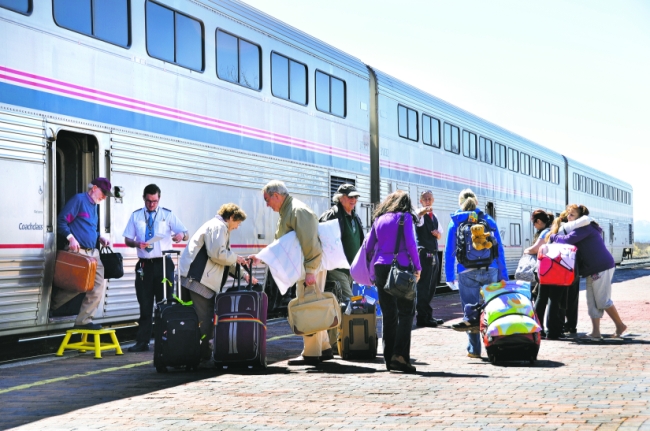
Outpost
By Rail
Grand Canyon
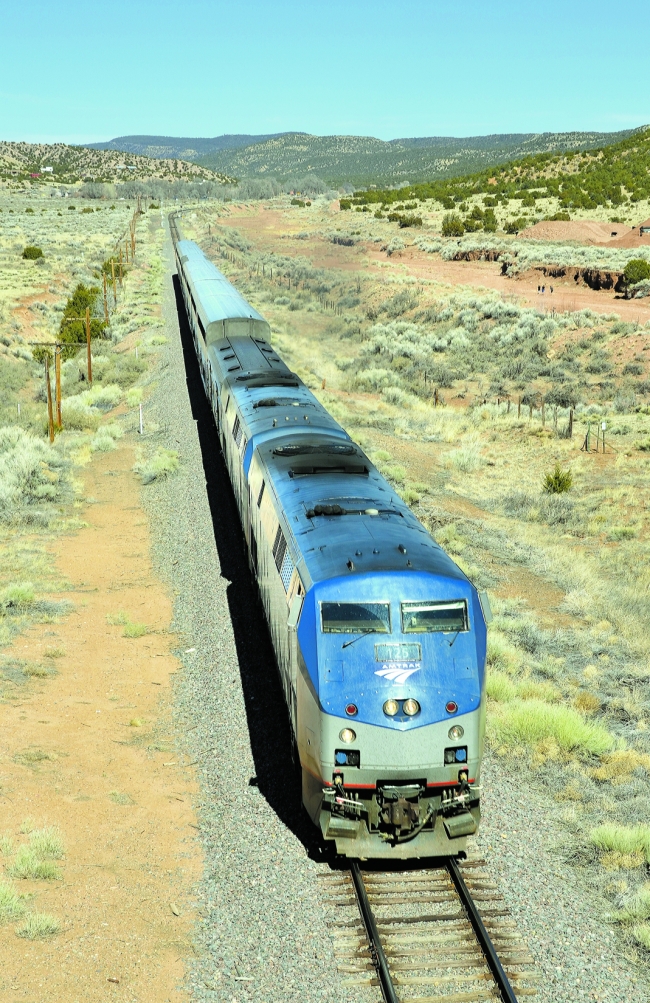
| Route 66 | Cities | Beaches |
Clothing |
Equipment |
Vehicles |
Readings |
 |
OutpostBy Rail Grand Canyon |
 |
| Grand Canyon | Getting There | Route 66 and I-40 | By Air via Las Vegas |
| Taking the train to the Grand Canyon is its own adventure. This was one of the great historic rail routes across the West. The tracks were first laid by the Atchison & Topeka Railroad, which merged with the Santa Fe to create the AT&SF. In the golden era of passenger trains, the Super Chief, which ran from Chicago to L.A., was a glamorous ride of movie stars, politicians, athletes, musicians and business tycoons. The dining car meals were legendary, the service equal to the finest hotels, and the 48 hour time unbelievable for the early 21st Century. Vacationers travelling to the Grand Canyon got to watch the Great American West rolling by just outside their window : cowboys, Native Americans, oil wells, farms, high plains, deserts, mountains, cities, small towns and the traffic on Route 66. Today's Amtrak Southwest Chief is not the elegant experience of the Super Chief, but it is still a great way to reach the Grand Canyon. | 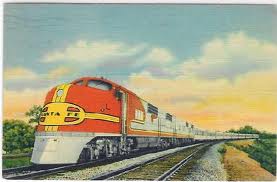 |
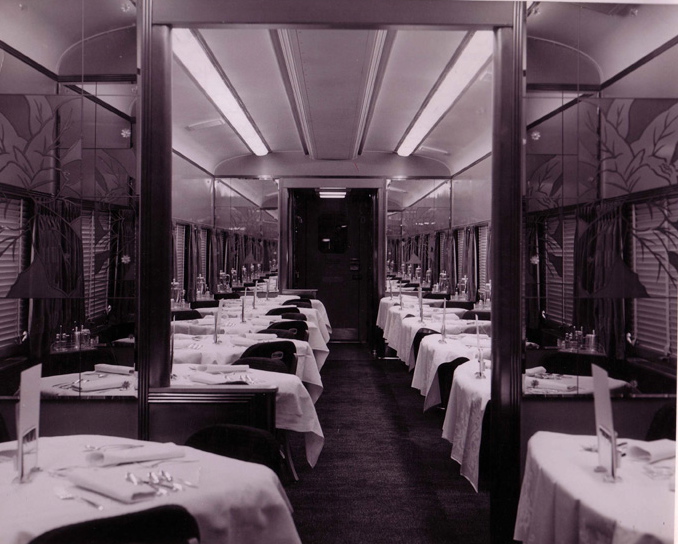 |
At left is the Super Chief dining car. At right is the modern SW Chief. The candles are missing but it's still elegant. Meals are included in your sleeper compartment ticket. The valet stops by your car to take your order and seating time. When you arrive at the dining car your meal is ready. Menus are limited to a meat, a fish, a chicken, and a vegetarian dish each meal, accompanied by a soup, salad, sides, dessert and drink. All are excellent. | 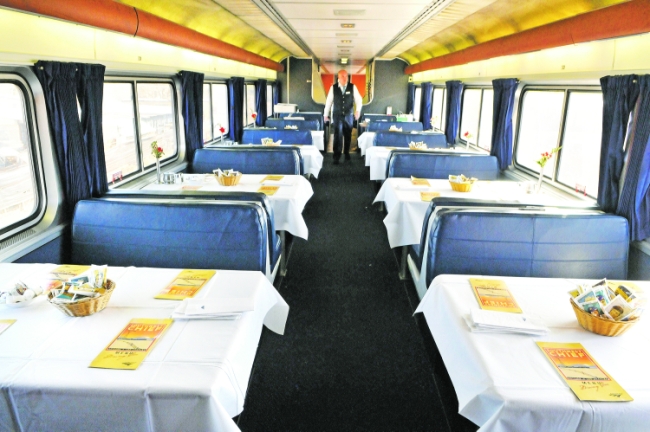 |
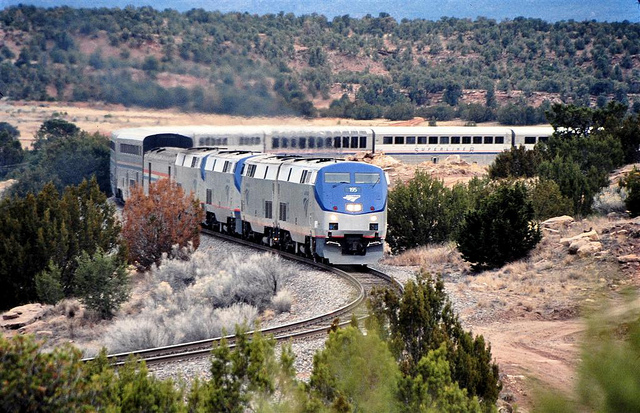 |
Amtrak runs two routes through the Ohio Valley. You can board at Pittsburgh, Youngstown, Cleveland, Toledo or Fort Wayne, or at Huntingdon, Cincinnati or Indianapolis. Either way, you arrive in Chicago in the morning, have a few hours to walk around the downtown, and change trains. The SW Chief pulls out at 3 pm and arrives at Williams, AZ the next evening. You'll spend the night at the Grand Canyon Hotel, then board the Grand Canyon Railroad for the two hour trip to the South Rim. All of this is arranged by your Amtrak travel agent. You'll receive your ticket packs in the mail. There will be six : one to Chicago, one to Williams, one to the Canyon, one back to Williams, one back to Chicago, and one home. This may sound very complicated, but it's much smoother than the airlines, and you don't have to worry about luggage being lost, because you take it with you. |
You'll purchase sleeper compartments, one from home to Chicago, one from Chicago to Williams. The Standard, shown here at right, has two beds in bunkbed format (notice the ladder to the upper bunk seen at lower right). A family compartment has two additional beds for the kids. During the day the beds fold into the walls and seats come out. The attendant takes care of this while you're at dinner and breakfast. Bathrooms and showers are down the hall. Sleeping on a train is a magical experience. The car rocks gently on the rails and you drift off to sleep gazing out the open window at lights twinkling in the distance or mountains against the sky. The beds and pillows are quite comfortable. The attendant will wake you in time for breakfast. |
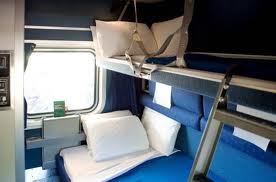 |
| During the day, you can either relax in your compartment, or wander the train. Snacks are available in the dining car between meals. WiFi and electrical connections are everywhere, so you can use your laptop, IPad, Kindle or phone. Businessmen often work en route, as seen at right. People email, twitter or surf the web. People often use the tables to play cards or board games. The best places to read are back in the compartments. Attendants deliver newspapers from whichever cities the train stops in that day. |
|
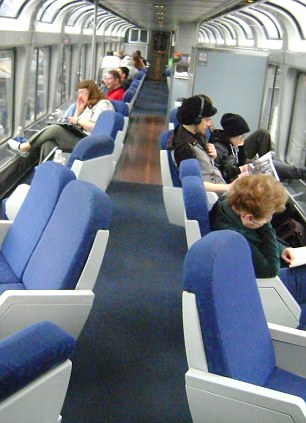 |
One way to spend several hours is in one of the Observation cars. Single and double seats swivel to face the windows and the glass wraps around overhead so you can look up at mountains, cliffs, sky, bridges or buildings. This is really the classiest way to travel. Railroads often go through more remote country than highways so you have access to scenery you can only see from a train. You also get to meet the people travelling with you, who are from various states and foreign countries. |
| There are some compromises you have to make to travel by train. First, you lose control of your own schedule. This is a serious problem in the Ohio Valley states, because we're "between" major cities. Long distance trains begin in Washington, New York and Boston, and again in Chicago and St. Louis. So they get the ideal arrival and departure times. We get inconvenient, and sometimes truly obnoxious times. For instance, Amtrak leaves Pittsburgh for Chicago at midnight. It leaves Charleston at 8 pm, Huntingdon at 930, Maysville at 1130, and Cincinnati at 120 am. Coming back, Amtrak leaves Williams, AZ at 3:50 am. Of course, once you board the train, you can go to bed and sleep uninterrupted. But those middle of the night departures take the fun out of it. Once you get to Chicago, life gets better. You pull in at 10 a.m. and have four hours to explore the city (and the station is downtown) before loading for a 3 pm departure. | 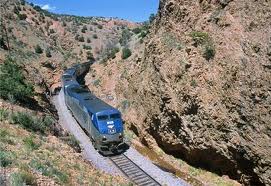 |
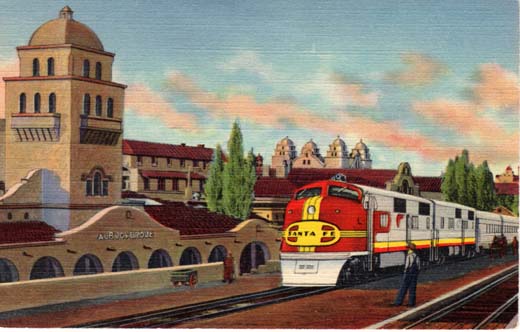 |
One way to beat this if you live close enough is to drive to St. Louis. The Missouri River Runner zips back and forth between St. Louis and Kansas City. You can leave, say, Lexington or Cincinnati at 9 am, get to St. Louis on I-64 by about 3 pm, and catch the afternoon River Runner at 4 pm. It arrives in Kansas City at 940. The Southwest Chief coming through from Chicago pulls in at 10 pm and departs at 1045. A day later, the Chief pulls into Williams, AZ at 930 pm. You spend the night at the Grand Canyon Hotel, then board the Grand Canyon Railroad at 10 am for the two hour run to the South Rim. Coming back, you reverse the process. On that return trip, you'll get into Kansas City at 730 am, and the River Runner departs at 815, getting into St. Louis at 2 pm. You can be home by dark.
|
| The cost for this St. Louis - Grand Canyon round trip is $2160 for a couple. That sounds steep. But remember if you drive, it will take four or five days each way. You'll be paying for at least eight nights in motels, three meals a day in restaurants, plus filling up with gas two or three times a day at $50 a tank. The gas alone will run $800-1000, the motels at least $560 and the meals at least $640. That totals $2000-2200, not counting wear and tear on your vehicle and the chore of driving. Going by Amtrak, your ticket covers three good meals a day, a comfortable bed, no vehicle wear, and you relax and enjoy the trip. The trains are meticulously clean (crews clean them thoroughly inside and out at each major stop as seen at right) and you can get work done, read a good book, socialize with fellow travellers or just relax and watch the scenery roll by. You also have the chance to get off at the major stations along the way. That's the old Super Chief stopped in Albuquerque in the photo above. | 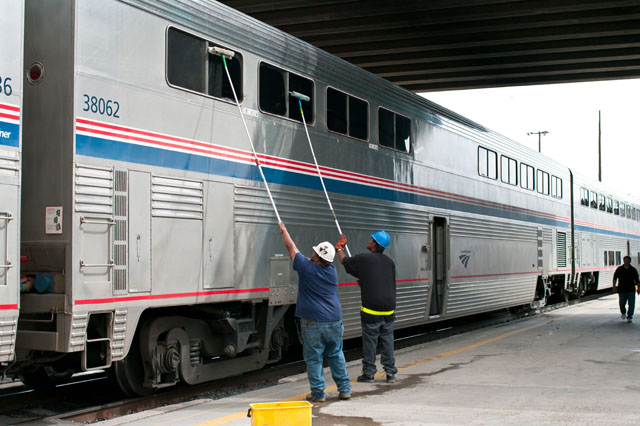 |
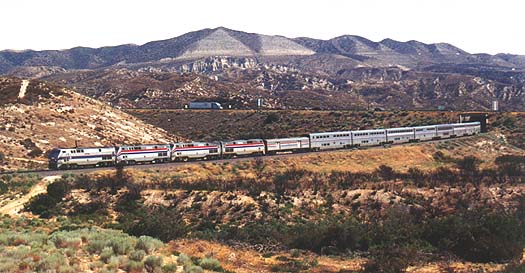 |
As you travel across the country, national park service rangers board at key points and ride with you until the next stop, pointing out key spots and explaining the history, geology, plant or animal life. Each Southwest Chief includes two locomotives the whole way and extras as needed at especially long steep grades. It includes one baggage car, three sleeping cars, one dining car, one lounge car and three coach cars. Outside the cities and steep grades, the Chief cruises at 90 mph. The Super Chief was the longest distance passenger train in the nation back when each railroad proudly provided this service, and now the Southwest Chief is the longest distance passenger train Amtrak offers. It is definitely an option to consider. |
|
|||
|